|
I recently had to replace the auxiliary fan motor on my 87 GLHS Charger because the bearings inside were worn out making it rattle as well as strike the oil filter.
There are a number of options for REPAIR, none of which include simply going to the local parts counter and getting a new one...they are NS1/no longer available from Mopar.
Option 1: HAVE THE ELECTRIC MOTOR REBUILT
Have a small electric motor repair company rebuild your original. I was never able to find a company that would be able to do this. All the electric motor repair places that I located on the Internet could only repair larger electric motors for elevators, large heating and cooling systems and the like. Due to the size and original replacement costs, they are just not interested and even if so, the cost would be quite expensive. You may have better luck with this.
Option 2: REPLACE THE FRONT MOTOR BEARING #608ZZ 8x22x7 ABEC-7
Most of the problems I have seen with this motor have to do with the bearings wearing out due to lack of lubrication. For this procedure you will need an appropriate ball bearing(see below), three small rivets, some JBWeld, two electric motor brushes, 2 wire crimps. Assorted tools, dremel tool with cut-off wheel.
The front of the electric motor shaft is supported by a ball bearing. The bearing (the one on the fan side) is a standard ball bearing that can be purchased anywhere you can find it. I purchased a set of ten of these from an on-line roller blade shop. It is a double sided sealed bearing, a perfect and exact replacement and they are inexpensive.
PICTURE

The number on the bearing is "608ZZ". One source for bearings is VXB Ball Bearings.
The rear of the fan shaft is supported by a bronze bushing that I've not yet seen wear out. Typically you can simply grease this bushing with 3n1 and also coat the wiper felt on top of it with several drops of 3n1.
You have to actually open the fan housing to perform this bearing service. To do this I simply used a dremel tool and a cut-off (ziz wheel) to remove the small portions of metal that are crimped over the cover to hold the cover to the housing. Only remove the crimp over tabs from 1/2 of the diameter, thats all that is needed. Once this is done its a simple matter to rasie the cover off the housing with a little work here and there, prying it up being carefull not to bend the cover. This will expose the lower bushing and make it easier to remove the upper bearing. The upper bearing is held in place with three small rivets, which you should carefull drill out or grind the back side off. DO NOT make the hole it goes through any larger if you choose to drill it out because you need to re-rivet it back together. You will of course also need to get these small rivets, you wont find them at HomeDepot either. Try Hilti or any other fastener supply. I found mine at the local BMW dealer, they are used to hold on interior trim panels.
If you also want to replace the brushes while you are in there it would be a good idea, most electric motor supply houses will have these. The challenge you will face in replacing the brushes is that they both are crimped to the wire that exits the housing on its way to the electrical connector on the end. You should not just solder them to the wire, the solder will not hold very long. You will have to crimp them on with and appropriate electrical crimping tool.
Reassemble the housing after servicing the bearing and either use a punch to re-crimp the portions you removed with the dremel or as I do, mix a little JB weld (not JB Quick) and cover the seam where the top meets the housing. Give it a full day to dry hard as steel, it will last forever.
Option 3: PURCHASE AN 80's JEEP CHEROKEE AUXILIARY FAN
I think this is the option to go with unless you can get your original rebuilt. As it turns out the late 80's (like 86-88) Jeep Cherokee with the 6 cyl engine came with an auxiliary fan almost identical to the one in the Shelby GLHS cars. The only significant differences are the electrical connector used on the end and the length of the shaft that the fan attaches to. Both of these differences can easily be overcome. Here is how:
The fan you are looking for is manufactured by several companies, one of which is SIEMENS. The numbers on it are "PM 3648 12V" and "772-67690-01".
PICTURE
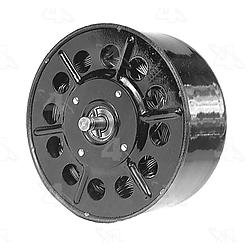
NAPA has the same item with a part # BK 6551661 for about $115. They seem to be the exact same part.
NAPAONLINE®
As far as the electrical connector goes, just cut the Jeep connector off the new fan right at the connector and then cut the connector off your old GLHS Dodge fan about 1"or 2" from the housing end leaving enough wire remaining in case some day you can get it repaired. The positive (red) wire should be attached to the male plug of the old GLHS connector. The male plug connector is the one that is exposed. The negavite (black) wire is attached to the femal side of the connector. The femals side has the metal portion inside the rubber portion, it can not easily bee seen without looking up inside the rubber portion. Obviously it important for the fan to spin in the correct direction or it will want to run hot at idle or when the AC is used.
PICTURE

The fan spins in the counter clockwise direction when you view the fan from the back side of the fan...which is the view that the engine would have. Viewing the fan from the front of the car, over the bumper cover, the fan spins in the clockwise direction.
The shaft on the new auxiliary fan is about 1/4" shorter than the GLHS fan shaft. It would be possible to remove the shaft from the old fan, disassemble the new fan and exchange the shafts. That's not very easy, but it is possible. I didn't take that route, I took a much easier route...here is what I did and it works great!
Place the new auxiliary fan in a vice, pad the jaws with shop rags and tighten it just enough to be snug. DO NOT OVERTIGHTEN the vice, it just needs to be snug. You are going to drill a hole in the end of the shaft and tap it to accept a small bolt. The bolt and a washer will hold the fan on. The bolt will replace the clip that is used on the OEM shaft.
Once the motor is in the vice, carefully center punch the end of the shaft. And they call it 'center punch' for good reason. Get the initial punch exactly in the center of the end of the shaft. Thre is very very little room for error here. Cover the fan cooling openings with a shop rag for sure BEFORE you start to drill, you absolutely do not want the filings down in the armature and housing. Now take a #30 drill (very very close to a 1/8" drill bit) and with some machineist oil or 3n1 slowly drill a hole straight down the fan shaft...all the way down to the roll pin hole. You really do want a #30 drill bit, but if a 1/8" is all you can come up with, that will work to except it will be harder to tap the hole. The roll pin, if it came with your fan will have to be removed from the shaft first! The roll pin is what supports the fan blade and they bend over time apparently. If you didn't get a roll pin with the fan, go buy a new one. Do not reuse the old roll pin if it is bent, even a little. It will get spit out over time if the fit is not nice and tight. When it spits out it could go into the fan and ruin the motor or allow the motor to run but the fan to spin slowly and ruin the center fan busing. NAPA has the pins, they are called spring pins and sell for about $.25 cents. Get one that is too long and dremel tool it down to be the correct length. The original roll pin is longer than the standard 1/2" size but less than 3/4"...go figure.
PICTURE

Once you have the #30 sized hole drilled straight down the shaft end, use a 4MM/.70 pitch metric tap to tap the hole with the appropriate threads. Again use machineist oil or 3n1 to tap this hole and go in just a few turns at a time, then back out the tap, wipe it, oil it, and re-insert. Turn it a few more turns and repeat till you have tapped all the way down to the roll pin hole. You will not be able to tap it all the way down because of the taper of the tap, but you will get it as far down as it needs to be. Just go slow with the tap till you reach the roll pin hole. When done, use compressed air to blow out the freshly tapped hole and the roll pin hole; now remove the rag that is covering the fan cooling holes carefull, dont spill any metal shavings into the fan.
Using a drift or punch, gently tap in the new roll pin so that it is properly centered. The correct length pin will remain inside the circle that is created by the bearing retainer plate. Any longer than the the diameter of that circle and when the pin begins to bend down, it will start to scrape the bearing housing. It will make a horrible racket so get the length right to begin with.
When you mount the fan blade on the new motor shaft, the end of the motor shaft will be about 1/16" of an inch below the top of the fan bushing. You can simply put a 4mm lock washer in the bushing hole to take up this slack...and that little $.02 cent washer is very very important. If you just mount the fan without it, and you tighten down the bolt hard enough to get it snug, it will just bend the roll pin over time, loosten up and the bolt will come out, allowing the fan to come off the shaft. Either put in the lock washer or grind down a 4mm flat washer to fit in that hole to take up the slack.
PICTURE

Also, the three small rivits that hold the bearing in the motor may rub on the bottom of the fan once mounted. Even if it doesn't initially it probably will start to hit them after a while si its a good idea to go ahead and use a die grinder to remove a little bit of the plastic material on the back side of the fan before you assemble. The area that needs to be trimmed down is easy to see...turn the fan over, moving out from the center there are ribs. Every other rib has a small post molded in the rib. The post is exactly where the rivet will hit. Simple remove about 1/8" of plastic from the top of each post as well as from the adjacent rib that will not have the post molded in. The area to remove will be about 1/4" wide. Do this now, before assembly and it will never hit, even as the roll pin starts to bend over time.
PICTURE
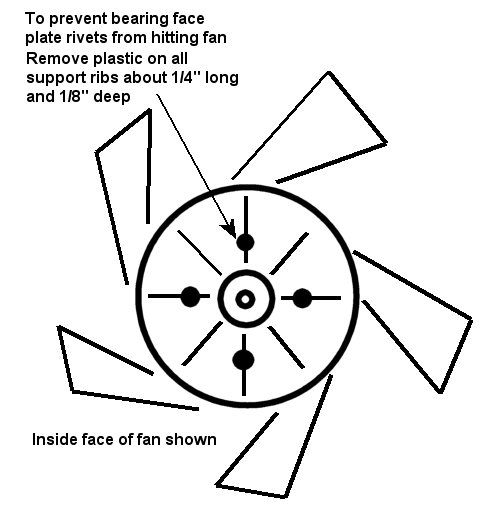
Coat the shaft of the motor with a little anti/never seize and mount the fan blade. Attach the fan with a 4MM/.70 bolt at least a 1/2 long...3/4 is about the ideal length but may require an additional 4mm fender washer. Be sure to use as thick a 4mm fender washer as possible while still allowing enough threads to enter the shaft. Use a 4mm lock washer, a fender washer and put some medium strength blue locktite on the bolt and then insert and tighten it to be pretty snug BUT DONT CRANK DOWN ON IT or you will bend the roll pin. Be sure to also put the lock washer or flat washer (as many as it takes under the fender washer to take up the slack created by the shaft being just a little too short. Done this way, the roll pin will not have to take any extra pressure and it will be much less likely to ever bend nor give you any problems.
Option 4: REPLACE THE ENTIRE FAN ASSEMBLY WITH A SLIMLINE FAN
You can simply remove the OEM GLHS fan and it's shroud with an aftermarket slimline design auxiliary fan. There are a number of slimline fans available from a variety of manufacturers. The total thickness of the fan needs to be less than 4". Ideal thickness is 3.5" and under but the 4" will also fit. The best fan width and height is 14 x 14. Try to select a unit that moves at least 1400CFM, that is close to the original OEM fan output. The more the better.
Unfortunatly, these slimline fans will not allow you to retain your OEM fan shroud and this will REDUCE the fans cooling efficiency quite a bit. When you install a slimline, typically it is mounted right against the cooling fin surface of the radiator using 'thru-the-fin' ABS mounting straps and the area outside the slimline fan frame is not being used to cool your engine coolant while the fan is running and the car is not in motion...so in heavy traffic or at stops you MAY notice your engine coolant temp a bit higher than before. Assuming your radiator is doing its job, it should not be a problem. Thats a big assumption on 20+ year old radiators.
Summit Racing has a number of fans available. These are the ones that will work and that I have tried or at least measured for a snug fit.
Mr gasket model 1987 1800 CFM
Summit Racing: Mr. Gasket 1987 - Mr. Gasket Electric Cooling Fans – SummitRacing.com
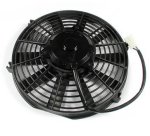
Flex-a-lite Syclone S-Blade Electric Fans 1505 CFM
Summit Racing: Flex-a-lite 394 - Flex-a-lite Syclone S-Blade Electric Fans – SummitRacing.com
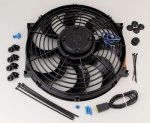
Hayden Automotive 3690 - 1250 CFM
Summit Racing: Hayden Automotive 3690 - Hayden Electric Fans – SummitRacing.com
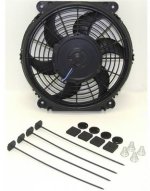
Of course you will also have to move the electrical connector from your old fan to the new slimline fan. Be sure that when the fan is running that it is blowing air on the motor and pulling air through the radiator, not trying to push it out through the bumper cover vents!
|